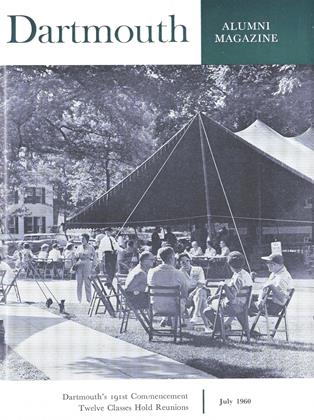(Third Edition). By
Francis W. Sears and Mark W. Zemansky.Reading, Mass.: Addison-Wesley PublishingCo., 1960. 1024 pp. $9.75.
When two outstanding teachers of physics combine their talents to write a textbook for introductory physics the result is almost unbeatable. College Physics by Francis Weston Sears of Dartmouth College and Mark Waldo Zemansky of the City College of New York, in its first and second editions, has become the norm against which other textbooks are compared. It is the prime competitor in the field, and it has been translated into several foreign languages. This new edition with added material, new diagrams, and reorganized chapters and problems is an improvement over the earlier ones. In it the emphasis is on physical principles; historical background and practical applications have been given a place of secondary importance. Anyone who has listened to lectures by either of the authors can attest to his lucid explanations of physical phenomena and above all to his insistence on a clear understanding of the physical principles involved. Their textbook incorporates these features.
Traditionally introductory physics is divided into mechanics, heat, sound, electricity and magnetism, light, and atomic physics. All but atomic physics were brought together for the first time a little over 100 years ago by Ganot in his Elements de Physique. This famous treatise was translated by Atkinson of the Royal Military College at Sandhurst, England, in 1863 and survived through many editions into the twentieth century. CollegePhysics is one of its most recent successors. In comparing these textbooks one is struck not only with the growth that has taken place in physics but also with the changes in emphasis and methods of presentation of the subject matter. Sears and Zemansky devote more space to mechanics and less to heat; more to light and less to sound; more to electrodynamics and less to electrostatics. In addition, their book contains the elements of atomic and nuclear physics, electronics, and other topics in twentieth century physics.
Perhaps the most striking difference between Ganot and Sears and Zemansky is found in the quantitative treatment of topics in physics. During the last hundred years textbooks in elementary physics have become less descriptive and more analytical. Even so, College Physics "consists exclusively of material suitable for students whose mathematical preparation goes no further than algebra and the elements of trigonometry."
At less than a penny per page, the new College Physics by Sears and Zemansky is an invaluable source of fundamental physics.
 View Full Issue
View Full Issue
More From This Issue
-
 Feature
FeatureThe Disinterested Citizen and the Maintenance of Freedom
July 1960 By WHITNEY NORTH SEYMOUR, LL.D. '60 -
 Feature
FeatureThe Fifty-Year Address
July 1960 By ANDREW J. SCARLETT '10 -
 Feature
FeatureHONORARY DEGREE CITATIONS
July 1960 -
 Feature
Feature1960 Commencement
July 1960 By D.E.O. -
 Feature
FeatureThe Image of the Educated Man
July 1960 By HARRISON CASE DUNNING '60 -
 Feature
FeatureThe Reunion Week
July 1960
ALLEN L. KING
-
 Letters to the Editor
Letters to the EditorLetters to the Editor
March 1980 -
 Feature
FeatureA Scientific Centennial for Dartmouth
OCTOBER 1969 By ALLEN L. KING -
 Article
ArticleDartmouth Names on the Moon
MARCH 1971 By ALLEN L. KING -
 Article
ArticleThe Toppled Towers of Wilder
JUNE 1973 By ALLEN L. KING -
 Feature
FeatureTHE 18th century highboys of Benjamin Randolph's
April 1976 By ALLEN L. KING -
 Article
Article'My Own House'
October 1976 By ALLEN L. KING
Books
-
 Books
BooksGALLANT PELHAM: AMERICAN EXTRAORDINARY.
APRIL 1959 By ALLEN R. FOLEY '20 -
 Books
BooksGUSTAVUS SOHON'S PORTRAITS OF FLATHEAD AND PEND D'OREILLE INDIANS,
March 1949 By Elmer Harp Jr. -
 Books
BooksTHE CURVE OF SOCIETAL MOVEMENT
AUGUST 1930 By J. W. Young -
 Books
BooksALUMNI PUBLICATIONS
August, 1925 By James F. Colby, H. D. Foster -
 Books
BooksTHE FOUNDATIONS OF FREEDOM: THE INTERRELATIONSHIP BETWEEN DEMOCRACY AND HUMAN RIGHTS.
JULY 1966 By KALMAN H. SILVBRT -
 Books
BooksHUMANISM AND POLITICS. STUDIES IN THE RELATIONSHIP OF POWER AND VALUE IN THE WESTERN TRADITION.
JUNE 1969 By MAURICE MANDELBAUM '29

